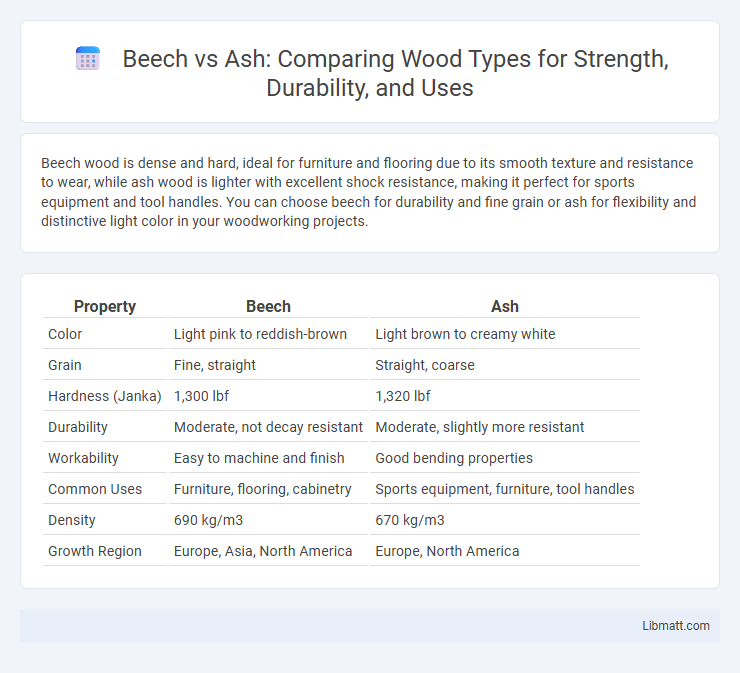Beech wood is dense and hard, ideal for furniture and flooring due to its smooth texture and resistance to wear, while ash wood is lighter with excellent shock resistance, making it perfect for sports equipment and tool handles. You can choose beech for durability and fine grain or ash for flexibility and distinctive light color in your woodworking projects.
Table of Comparison
| Property | Beech | Ash |
|---|---|---|
| Color | Light pink to reddish-brown | Light brown to creamy white |
| Grain | Fine, straight | Straight, coarse |
| Hardness (Janka) | 1,300 lbf | 1,320 lbf |
| Durability | Moderate, not decay resistant | Moderate, slightly more resistant |
| Workability | Easy to machine and finish | Good bending properties |
| Common Uses | Furniture, flooring, cabinetry | Sports equipment, furniture, tool handles |
| Density | 690 kg/m3 | 670 kg/m3 |
| Growth Region | Europe, Asia, North America | Europe, North America |
Introduction to Beech and Ash Wood
Beech wood, derived from the Fagus genus, features a fine, tight grain and pale cream color, making it ideal for furniture and flooring due to its hardness and durability. Ash wood comes from the Fraxinus genus and is prized for its light color, straight grain, and excellent strength-to-weight ratio, often used in sports equipment and tool handles. Both hardwoods offer distinct aesthetic and mechanical properties suitable for diverse woodworking applications.
Botanical Background: Beech vs Ash
Beech (Fagus sylvatica) belongs to the Fagaceae family, characterized by smooth gray bark and dense, ovate leaves with serrated edges, thriving in temperate European forests. Ash (Fraxinus excelsior) is part of the Oleaceae family, distinguished by compound pinnate leaves, deeply furrowed bark, and produces winged seeds called samaras, commonly found across Europe and Asia. Both species play crucial ecological roles but differ significantly in leaf structure, bark texture, and seed morphology.
Physical Properties Comparison
Beech wood is dense, hard, and has a fine, tight grain with a smooth texture, making it durable and resistant to wear, ideal for furniture and flooring. Ash wood, while also hard and strong, is lighter in weight with a more open grain and excellent shock resistance, commonly used in sports equipment and tool handles. The higher density of beech contributes to greater weight and strength, whereas ash's flexibility and elasticity offer superior impact absorption.
Appearance and Grain Patterns
Beech wood features a fine, tight grain with a smooth, uniform texture and pale cream color that sometimes has pink or brown hues, making it ideal for modern and minimalist designs. Ash wood displays a more pronounced, straight grain pattern with a light tan to medium brown color, offering a distinctive, rustic look that highlights natural wood character. Understanding these subtle differences in appearance and grain patterns helps you choose the right wood for your furniture or flooring projects.
Strength and Durability
Beech wood is known for its hard, dense structure, providing excellent strength and moderate durability, making it suitable for furniture and flooring that endure regular wear. Ash wood offers superior toughness and elasticity, with high shock resistance and durability, often preferred for tool handles and sports equipment requiring resilience. Both hardwoods perform well under stress, but ash typically surpasses beech in impact resistance and longevity in demanding applications.
Workability and Ease of Use
Beech wood offers exceptional workability with its fine grain and smooth texture, making it ideal for detailed woodworking and easy sanding. Ash wood is known for its flexibility and shock resistance, providing a reliable and comfortable experience when shaping or bending, especially in tool handles and sports equipment. Your choice between the two depends on whether you prioritize precise finish and polish (beech) or durability with a bit more toughness during crafting (ash).
Common Uses in Furniture and Flooring
Beech wood is highly valued in furniture making for its fine grain, durability, and smooth finish, making it ideal for chairs, tables, and cabinetry. Ash wood is preferred for flooring and furniture requiring strength and flexibility, such as sports equipment and curved chair backs, due to its hardness and shock resistance. Both woods offer aesthetic appeal with light color tones, but ash provides better wear resistance for high-traffic flooring applications.
Cost and Availability
Beech wood is generally more affordable and readily available in Europe due to its widespread growth and faster maturation. Ash tends to be pricier, especially in regions where it is less abundant, reflecting its slower growth rate and higher demand for specialty applications. Both woods are accessible through major lumber suppliers, but beech offers a cost-effective option for bulk purchases compared to ash.
Environmental Impact and Sustainability
Ash trees offer a more sustainable option than beech due to their faster growth rate and greater carbon sequestration capacity, making them beneficial for reforestation projects and carbon offset initiatives. Beech wood, while durable, often requires more intensive management and may contribute to habitat disruption if not sourced responsibly. Prioritizing ash supports biodiversity and reduces environmental footprint through efficient resource utilization and enhanced ecosystem services.
Choosing Between Beech and Ash
Choosing between beech and ash depends on your specific woodworking needs and aesthetic preferences. Beech offers a fine, tight grain with excellent hardness and smooth finish, ideal for furniture requiring durability and a classic look, while ash provides a more open grain with greater flexibility and shock resistance, perfect for athletic equipment or curved designs. Consider your project's balance of strength, appearance, and workability to select the wood that best enhances your craftsmanship.
Beech vs ash Infographic

 libmatt.com
libmatt.com